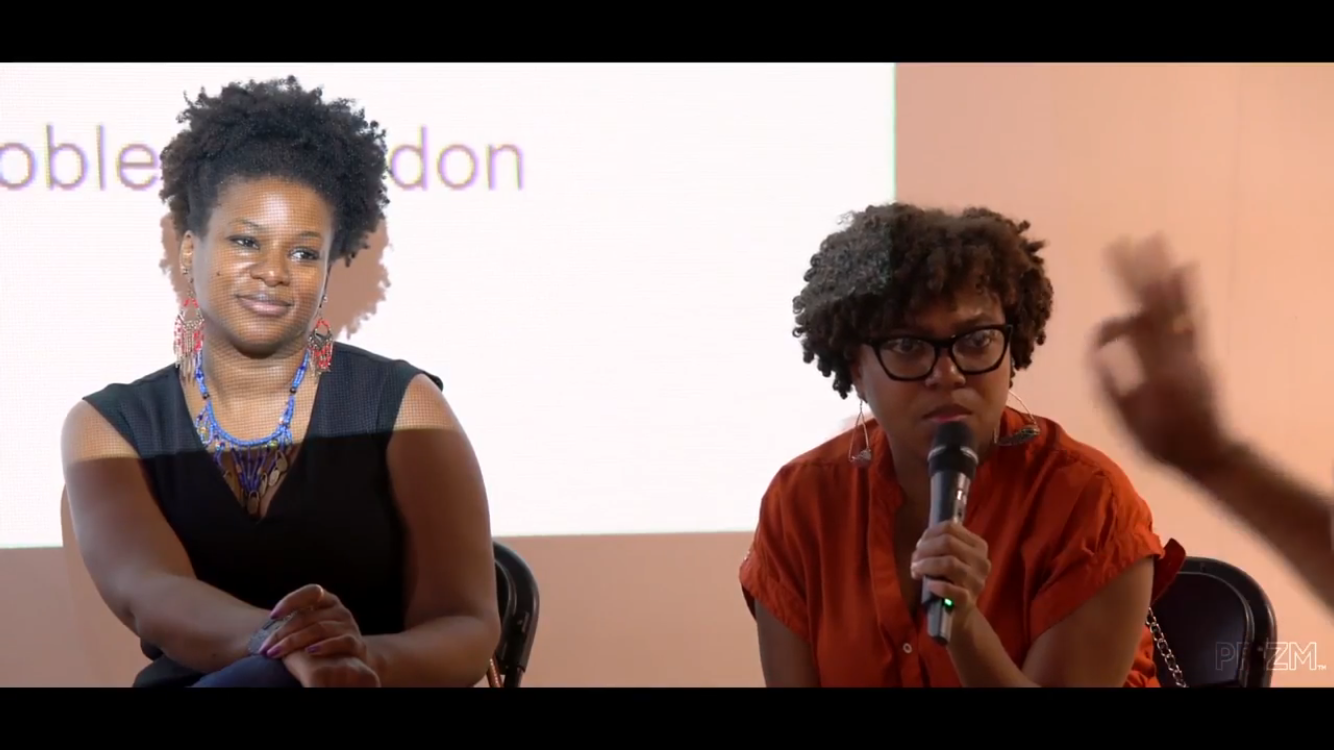In DC, neighborhoods are facing an unprecedented amount of change in appearance, racial makeup, and social policies that runs counter to the once-prevalent idea of DC being “Chocolate City.” However, there are ways to balance change with paying respects to DC’s living history. The Nicholson Project, an artist residency that recently opened in Ward 7, hopes to demonstrate this change effectively with the inaugural resident artist Amber Robles-Gordon, who lives only eight minutes from the building. For me, it feels like a house turned into a relic, with its period-accurate rehab details; however, the Nicholson Project owners do not focus on the actual former owners, but highlight contemporary artists of color instead.
Read MoreLarry Cook Jr.
Co-Founders of Delusions of Grandeur at Prizm Art Fair

Contemporary Black Artist Movements: Artists Jamea Richmond-Edwards and Amber Robles-Gordon, Co-Founders of Delusions of Grandeur artist collective will speak of the relevancy, evolution and power of artist collectives and artistic movements. Richmond-Edwards and Robles-Gordon, parlayed a series of conversations about personal experiences in the art world, the cultural influence and legacy of Howard University, and the examination of artist group and movements such as Spiral, Black Artists of DC, Africobfra and the Black Arts Movement to build a contemporary art cannon.
Read MoreThe Group Exhibition Lest We Forget at Galerie Myrtis reviewed by Angela N. Carroll
often wonder how these times will be remembered. What will future generations learn from this moment? Which stories will historians archive? What experiences will be forgotten? Watching the insanity of this election cycle has confirmed for me the importance of knowing histories; not just your own, but the distant and contemporary, local and international happenings that have shaped our present.
The rhetoric employed by the extreme wings of the GOP has empowered and emboldened embarrassingly inaccurate and flatly supremacist depictions of American history. Slogans like “Make America Great Again” assume that the growth of America’s empire occurred without the toil of immigrants, people transported by force, or those who relocated in the hopes of accessing the freedoms of democracy.
A recent poll released by Reuters revealed that 38% percent of American voters continue to support the GOP’s candidate despite his blatant disregard for anyone other than white men and general dismissal of fact-based platforms. I dare not try to understand the irrational reasoning of deplorables, but urge critical thinking voters to remember the whole and diverse contributions that sustain America. Lest we forget all those that came before us, live among us– the laboring bodies that support the world.
The exhibition titled Lest We Forget curated by Deirdre Darden and Jarvis DuBois at Galerie Myrtis interrogates a legacy of historical cultural bias; the conceptions that determine a story’s archivism or omission from history. Artists Wesley Clark, Larry Cook, Shaunte Gates, Jamea Richmonds-Edwards, Amber Robles-Gordon, and Stan Squirewell, collectively known as Delusions of Grandeur, and Delita Martin all contribute their own reflections about forgotten experiences in order to build a richer, more inclusive, and more accurate vision of history.
Read MoreIn the galleries: Heading home

By Mark Jenkins, Washington Post
F. Scott Fitzgerald, group portraits and that R.E.M song. Lottery tickets, gentrification and a fast-food sign. These are among the artifacts and phenomena that define Rockville and D.C., respectively, in exhibitions that seek to reveal something of those places’ characters. The titles are telling. VisArts’s “(Come Back to) Rockville!” is a pep-squad cheer; Honfleur Gallery’s “How We Lost D.C.” is a blues lament.
Read More"How We Lost DC" at Honfleur Gallery Wednesday, Sept. 16

By Emily Walz, Washington City Paper
Few cities are undergoing a period of gentrification as lengthy as D.C.’s, and perhaps none are gentrifying as quickly. The individual stories of displacement, as well as the larger narrative arc that shows how class and racial lines overlap to push out poorer minority communities, have particular poignancy in D.C., one of the first cities in the U.S. with a black majority. Against this backdrop, the local African-American artist collective Delusions of Grandeur created How We Lost DC, an exhibition the group calls “a visual discourse on gentrification.” The work of Wesley Clark, Larry Cook, Shaunté Gates, Jamea Richmond-Edwards, Amber Robles-Gorden, and Stan Squirewell encompasses photography, textile, paintings, mixed media, and sculpture in a show that moves between portraiture and would-be artifacts to tapestry and art made from maps of the District itself.
Read More
